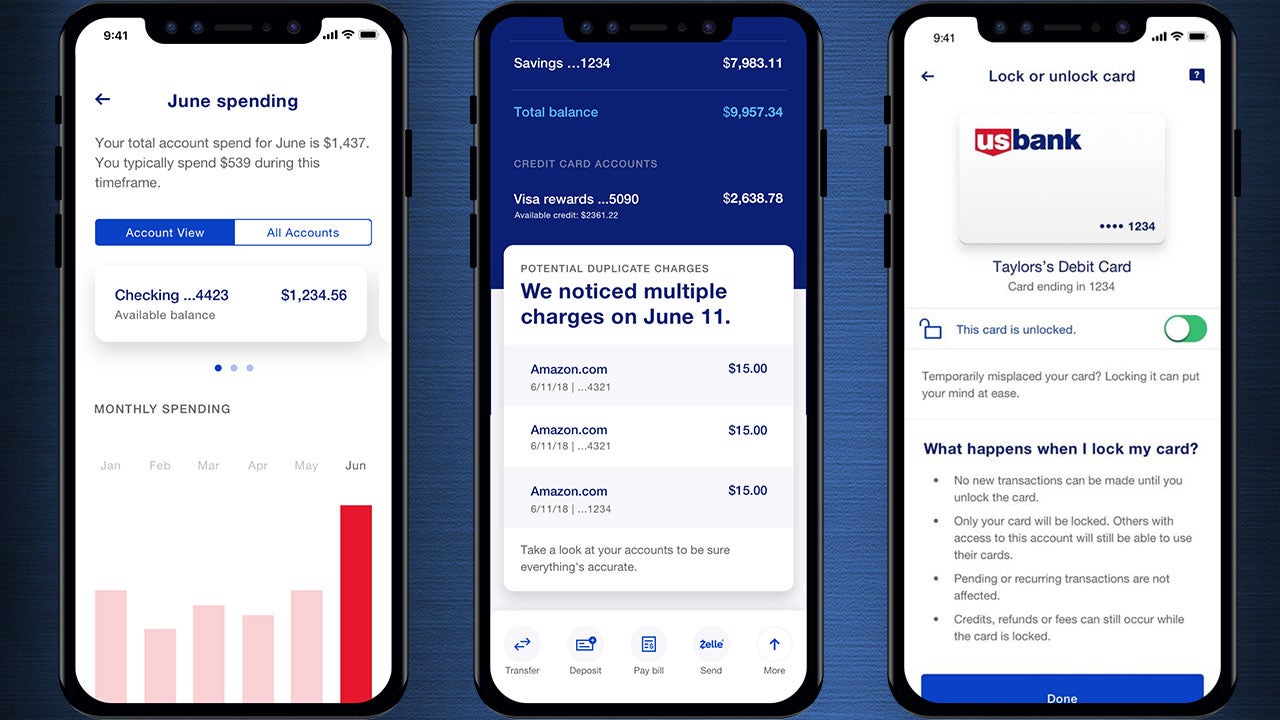5 key benefits of mobile banking




Mobile banking has become the norm in many consumers’ daily lives. The allure, of course, is the convenience mobile banking offers: Consumers tote their smartphones virtually everywhere, so a mobile banking app can help them quickly take care of a range of financial needs whenever they wish. It’s essentially a bank in your pocket.
Having tools that make it easier to manage your finances is especially valuable at a time when most consumers are struggling to save. To put it in perspective, Bankrate’s 2025 Emergency Savings Report found that 59 percent of Americans wouldn’t pay for a major unexpected expense, such as $1,000 for an emergency room visit or car repair, with their savings. Mobile banking offers expense tracking, automated savings, account access for those who might not have a branch nearby and more to aid in managing your finances.
Key takeaways
- Expense tracking, automated savings and easy access to account information are a few features that make mobile banking an essential tool for managing finances.
- Mobile banking apps also provide added security measures, such as encryption and biometric authentication, to protect sensitive financial information and prevent unauthorized access.
Advantages of mobile banking
Mobile banking apps can warn you when you spend more than you have in your account, automatically move money into savings on your payday and let you set controls on your cards to restrict spending. Banking apps can also make it easy to send money to friends and to reach a customer service representative with the tap of a button.
1. Accessing the bank 24/7
Unlike a bank branch, mobile banking conveniently gives you access to your account anytime you like — with some exceptions, such as planned maintenance updates and unexpected outages.
This ease of accessibility saves you time. Mobile check deposit, for example, a feature most banking apps offer, allows you to deposit a check on the go or from the comfort of your couch.
Mobile banking apps can also make it easy for users to schedule and pay bills at their convenience with features like bill pay and upcoming payment alerts. Customers can ensure bills are settled on time, regardless of whether it’s on the go or late at night.
2. Making it easier to save
The best mobile banking apps have evolved to help you manage your money with less effort. For example:
- The Ally Bank app offers several savings features, including automatic transfers to a savings account and round-ups that move rounded up change into your savings.
- The U.S. Bank app alerts customers when its algorithms spot money-saving opportunities or situations when an account is at risk of being overdrawn.
- Varo Bank offers a Save Your Pay feature that automatically stashes away a pre-set percentage of your paycheck each time it deposits.
3. Paying a friend
When you are logged into your mobile banking app, it’s easy to pay back someone you know.
Banks across the country partner with Zelle so that you can send someone money in minutes through the bank’s mobile app rather than paying people with cash or a check.
You only need to know recipients’ email addresses or phone numbers to send them money.
4. Strengthening security
Banks are in the business of guarding your assets — including transactions made using their mobile apps. Though nothing is foolproof, there are ways you can step up security precautions if you’re concerned about mobile banking security.
Financial institutions often require a username and password to sign into a mobile app and offer additional safety features to further safeguard your account, which often include:
- Multi-factor authentication: It requires at least two kinds of verification to prove that it’s really you. The first are the account credentials (your username and password) followed by a text with numeric code sent to your phone that needs to be submitted to gain access to the account.
- Fingerprint or facial recognition: Further, some mobile devices — and some bank apps — let you log in by scanning your face or fingerprint as yet another way to protect your digital bank account without trading convenience.
- Card lock feature: A growing number of banks, such as Wells Fargo, Ally Bank, Chase and Bank of America let you use their mobile apps to turn your debit or credit card off if it goes missing or is stolen. It’s a nice feature to help you feel instantly secure in a moment of panic. Calling a toll-free number is not required if you want to turn your card back on, either.
5. Tracking expenses
When it comes to managing and sticking to a budget, tracking all of your expenses is the part that requires the most labor, and it may lead you to give up on budgeting altogether. Mobile banking apps can do much of that labor for you, by keeping track of your expenses tied to a particular account and organizing them into spending categories. You can see a breakdown of total expenses for things like utilities, dining, transportation and more.
By reviewing your spending patterns, you should gain a clearer understanding of where your money is going and can identify areas where you may need to make adjustments.
Some apps even come with built-in budget creation. Regions Bank, for example, offers a suite of budgeting tools through a feature in its app called My GreenInsights. Users have the ability to set up a budget in the app, sync multiple accounts to it and monitor their spending progress.
Other banking apps allow you to set financial goals, such as saving for a vacation or paying down a debt. Ally Bank, for example, comes with features that let users establish and track progress toward different savings goals.
Disadvantages of mobile banking
Though mobile apps can simplify some banking tasks, they do have potential drawbacks.
Technical interruptions
Mobile banking relies heavily on the user’s mobile device and internet connectivity. If you don’t have your device or the network is slow, it can hinder your ability to perform mobile banking activities. Plus, not all mobile banking apps work well, and even the best ones encounter outages occasionally.
Lack of personal interaction
Mobile banking eliminates face-to-face interactions with bank tellers. While this might not be an issue for many customers, it can be a disadvantage for those who prefer assistance or have complex financial inquiries that require more in-depth guidance. However, some mobile banking apps may allow you to contact a banker over live chat. You can also always call your bank’s customer service.
Highly rated mobile bank apps
In 2025, mobile banking apps with standout features let you automate money decisions, block your cards, quickly get answers to your questions and more. Here are some of Bankrate’s favorites.
- Ally Bank: The online-only bank offers the staples, such as finding nearby ATMs and transferring funds and provides extra touches. You can use Ally Assist, a virtual assistant that can help initiate transfers and bill payments, as well as provide information on interest earned and patterns of spending and saving. You can also use the app to set up controls for your cards and create savings buckets to help organize your money.
- Bank of America: Among the standouts of the big bank’s app is Erica, a virtual assistant that can answer a wide range of financial questions. You can also use the mobile app to book an appointment with an in-person banker.
- Capital One: The Capital One app is easy to navigate, helps you save and includes Eno, a virtual assistant. Users can also add cash in store by getting a unique barcode through the app and then going to a participating CVS, Walgreens or Duane Reade.
- Chase: In addition to allowing you to send money to someone else and monitor your account, the Chase app shows you a simple daily snapshot of your spending and saving patterns. You can also set savings goals and track your progress.
- Chime: This nonbank fintech gives you daily balance alerts and allows you to block your card in-app. It also lets you set up rules to automatically save money and potentially get your payday up to two days early. You can also overdraw your account without paying a fee.
- M&T Bank: Rated the top regional bank for mobile banking in 2024 by J.D. Power, M&T Bank’s app is great for those who want to keep tabs on their money while on the go. Users can leverage the MoneySmart tool to easily manage cash flow, make purchases through the digital wallet, pay bills using the built-in feature, set account alerts and send or receive funds through Zelle. There’s also the option to redeem credit card perks directly from the mobile app.
- Varo: This online-only bank’s app lets you track your spending with instant alerts and send money to friends and family.
Is mobile banking safe?
A common concern among users is the safety of their financial information. Fortunately, banks have robust security measures in place to protect user data and money.
One of these measures is encryption technology. Encryption means that your sensitive information, such as login credentials and transaction details, remains confidential.
Mobile banking apps also incorporate multi-factor authentication (requiring users to provide multiple forms of identification to access accounts) or biometric authentication (requiring fingerprints or facial recognition to log in). Doing so adds an extra layer of protection against unauthorized access.
Still, there are some best practices to ensure you’re banking safely over a mobile device:
- Enable biometric authentication whenever possible.
- Regularly update your app. Developers often release updates that include security enhancements and bug fixes.
- Frequently check on your transaction history and account statements to quickly identify any unauthorized or suspicious activity.
- Avoid conducting mobile banking transactions on public Wi-Fi networks.
- Be cautious of phishing emails, messages or calls attempting to obtain your login information. Banks typically do not request sensitive information through these channels by reaching out to you first.
Bottom line
Mobile banking is designed to help you in all kinds of ways. Thanks to 24/7 access to accounts and the ability to make transactions with the tap of a button, consumers have more control over their money management and trips to the local bank, for many, are a thing of the past.
Why we ask for feedback Your feedback helps us improve our content and services. It takes less than a minute to complete.
Your responses are anonymous and will only be used for improving our website.




